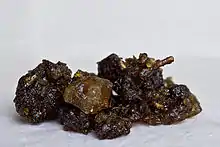Bdellium
La bdellium es una resina aromática como la mirra que es exudada de un árbol. El primer escrito medieval árabe que la mencionó la identificó con la goma guggul (Commiphora wightii).[1] Sin embargo, la palabra bdellium también se ha utilizado para identificar a la especie africana Commiphora africana y por lo menos a otra especie india, Commiphora stocksiana (que en sánscrito se llama kaushika).[2]

La resina bdellium se utilizaba como sustituto adulterado de la más costosa mirra (Commiphora myrrha).
La resina bdellium aparece en un número de fuentes antiguas.
En China, la bdellium ―conocida como hsiang hsi o aroma de Partia― fue una de las variedades de incienso que llegó a China ya sea a lo largo de la Ruta de la Seda de Asia Central, o por mar. Más tarde, hsiang hsi se aplicó a un sustituto de las Indias Orientales, el benjuí de goma de Sumatra.[3]
En acadio era conocida como budulhu.[4]
En idioma hebreo se llama bedolach, y en la Biblia hebrea aparece dos veces. La primera está en el Libro del génesis (2:12), donde se describe como un producto de la tierra de Javilá. El contexto ha llevado a algunos lectores a vincular la bedolach con perlas u otras piedras preciosas.[5]
La bdellium se menciona una vez más, como algo familiar en el Libro de los números, donde el maná se compara a ella en color:
El maná era como zera gad (semilla de cilantro), y su aparición como la aparición de la bedolach.Libro de los números (11:7).
En la India se la conocía con varios nombres sánscritos:
- āśāpuraguggulu
- āśāpurasambhava
- gandharāja
- gauggulava
- gaulgulava
- granthika
- guggula
- guggulu
- gugguluka
- gulgulu[6]
- jaṭāyu
- kaṇaguggulu
- kanaka
- kauśika
- uddīpa
- uddīpra
- udūkhala
- ulūkhala
- ulūkhalaka
- uṣa
El guggul todavía se utiliza como aglutinante en perfumes.
Teofrasto (371-287 a. C.) es quizás el primer autor clásico que lo menciona, en el informe que hizo a su regreso de la expedición de Alejandro Magno se refiere a Commiphora wightii:
En la región llamada Aria hay un árbol espinoso que produce una lágrima de resina, parecida a la mirra en la apariencia y el olor. Se licúa cuando el sol brilla sobre él.Teofrasto.[7]
Plauto (254-184 a. C.) en su obra Curculio se refiere a la bdellium.
Plinio el Viejo (23-79 d. C.) describe que la mejor bdellium procedente de Bactria como
...un árbol de color negro, y el tamaño de la aceituna del árbol, y su hoja se asemeja a la del roble y su fruto al higo silvestre.Plinio el Viejo.[8]
Pero sus descripciones parecen cubrir un rango de resinas perfumadas. En el texto Periplo del mar Eritreo (del siglo II d. C.), informa que la bdellium se exportaba desde el puerto de Barbarice, en la desembocadura del Indo.[9]
La resina bdellium fue un ingrediente en las recetas de los médicos antiguos desde Galeno (130-200) a Pablo de Egina (625-690), y en la Greater Kuphi.[10]
Etimología
Del griego bdellion, variante de bdolkhon, de origen semitico; afín al acadio budulhu.
Referencias
- Dalby, Andrew: Dangerous tastes: the story of spices, 2000. «Gum guggul», en la página 109f.
- Miller, J. Innes: The spice trade of the Roman empire. Oxford: Clarendon Press, 1969, pp. 69ff. Miller se refiere a esta especie por su sinónimo: Commiphora mukul.
- Joseph Needham et al.: Science and civilisation in China, vol. 5. Cambridge University Press, 1974, §33. «Alchemy and chemistry», p. 142f; y nota g.
- Miller, Spice trade, p. 69.
- El Idra Rabba (128b) describe la aparición de rocío descendiendo de la cabeza de Arich Anpin como «blanco como el color de la piedra bedolach, en la que se ven todos los colores». «Opening 89» Archivado el 6 de febrero de 2012 en Wayback Machine., artículo en el texto cabalístico 138 openings of wisdom; publicado en el sitio web Bar Mitzva.
- Dalby 2000, ibid..
- Noted by Dalby 2002, ibid.
-
Next to Ariane is Bactriane, which produces the most esteemed kind of bdellium. The tree is of a black colour and of the size of an olive-tree. Its leaf resembles that of the oak, and its fruit that of the wild fig-tree. Bdellium itself is of the nature of a gum. Some call it brochon, others malacha, others again maldacon, but when it is black and rolled into a little ball it is known as hadrabolon. This substance ought to be transparent like wax, odoriferous, unctuous when crumbled, and bitter to the taste but without being at all acid. When used in sacred rites it is steeped in wine to increase its fragrance. It grows in Arabia and India as well as in Media and Babylon. Some persons call the bdellium which is brought to us by way of Media, peratic. It is more brittle than the other kinds, harder in the crust, and more bitter to the taste; the Indian kind is, on the other hand, moister and gummy, and is adulterated by means of the almond nut. The various other kinds are corrupted with the bark of scordastum, the tree of this name producing a gum which resembles bdellium. The adulterations of perfumes, let it be said once for all, are detected by their smell, by their colour, weight, taste, and by the action of fire. The Bactrian bdellium is dry and shining, and has numerous white spots, like finger-nails in shape. Besides, it should be of a certain weight than which it ought to be neither heavier nor lighter. The price of bdellium when quite pure is three denarii per pound.Plinio el Viejo, en Historia natural (12.19).
- Dalby 2000.
- Miller, Spice Trade, p. 71.
Enlaces externos
- «Bdellium», artículo en inglés en el sitio web Alchemy Works.